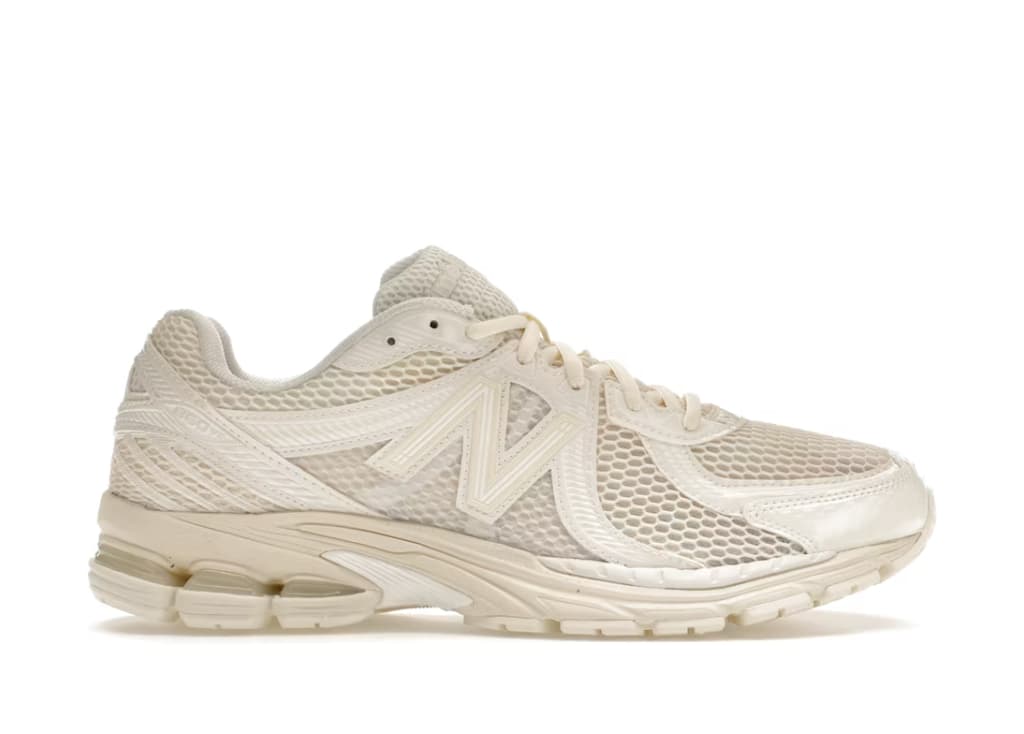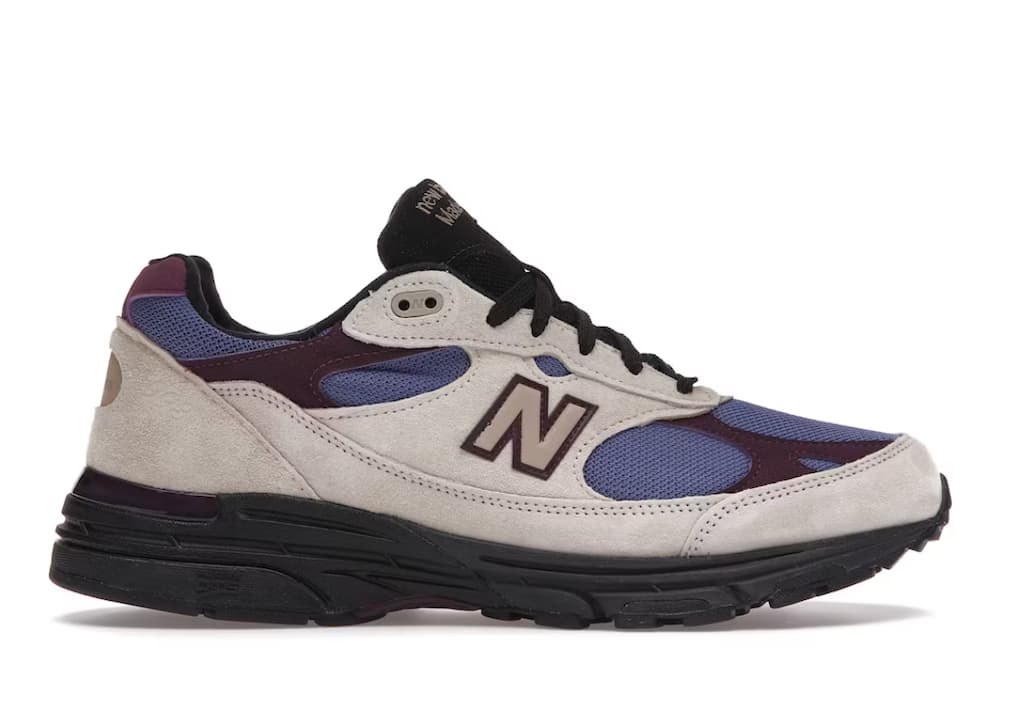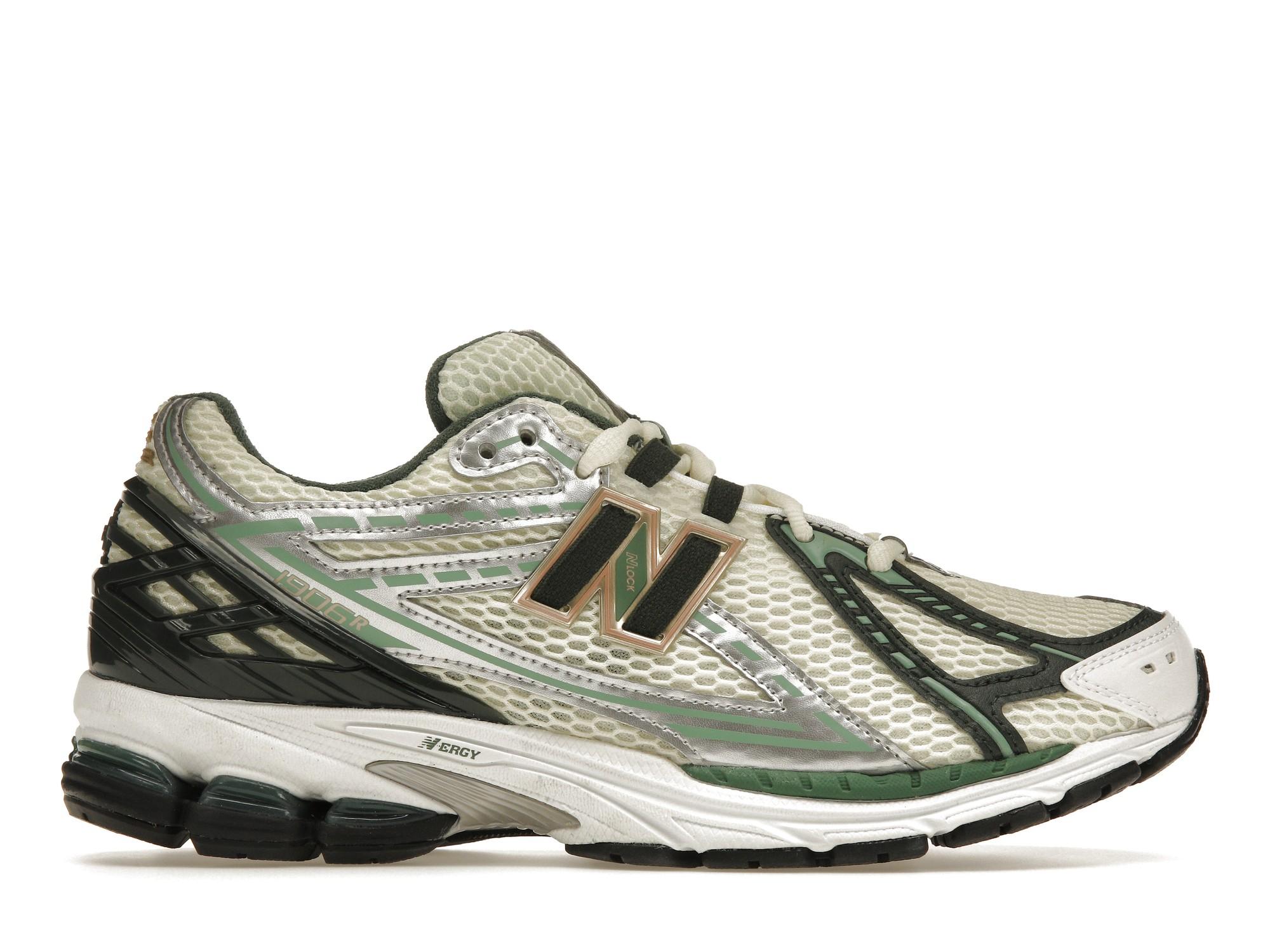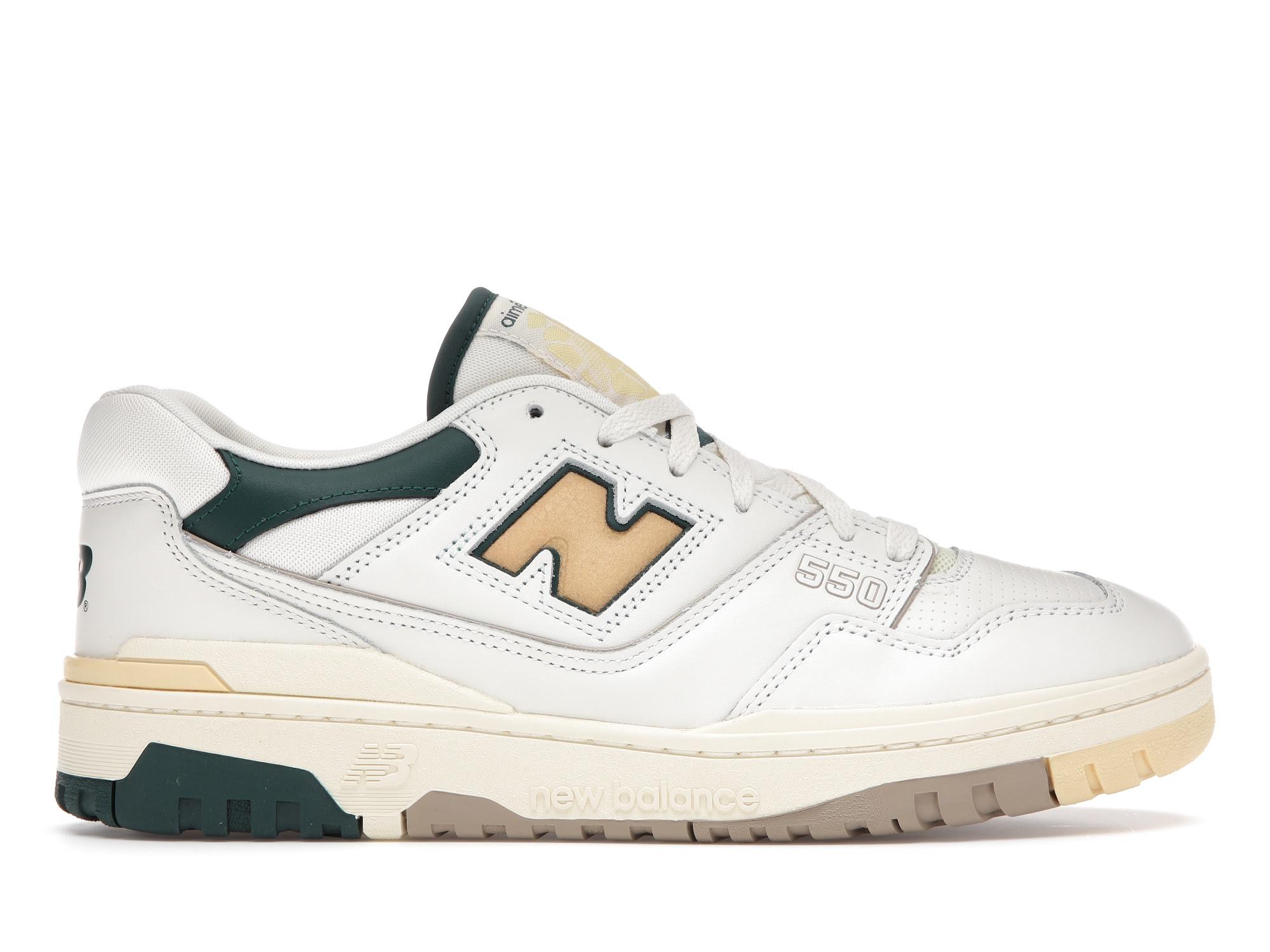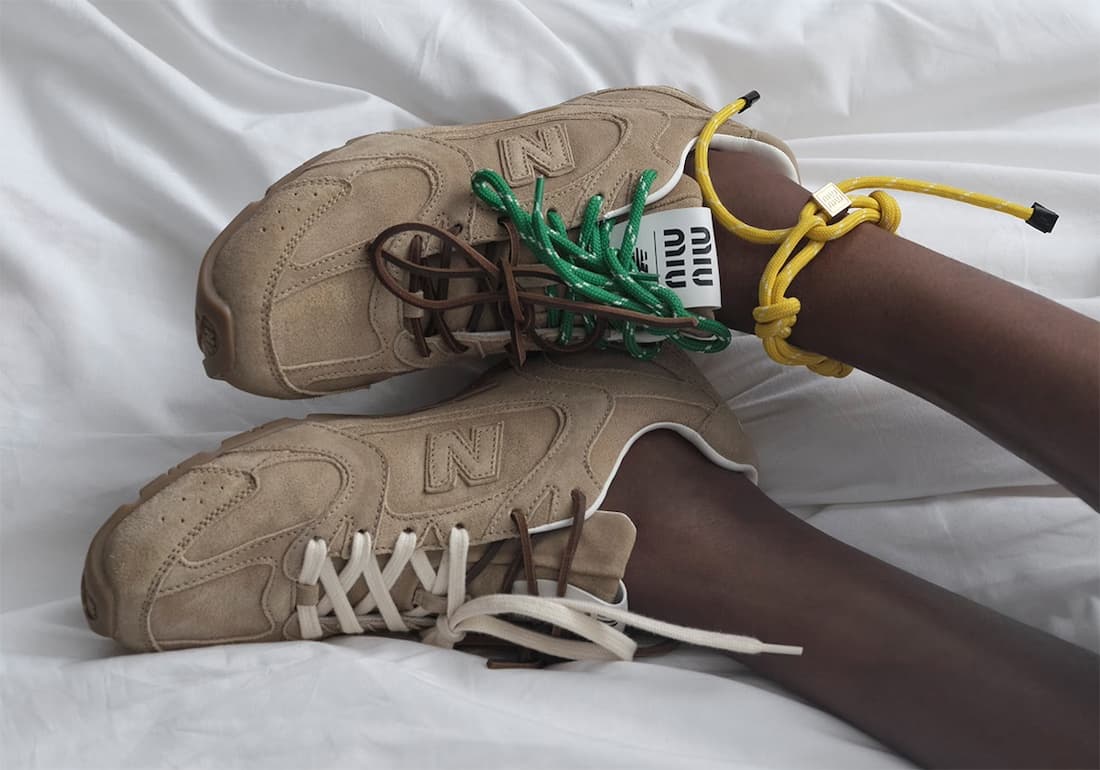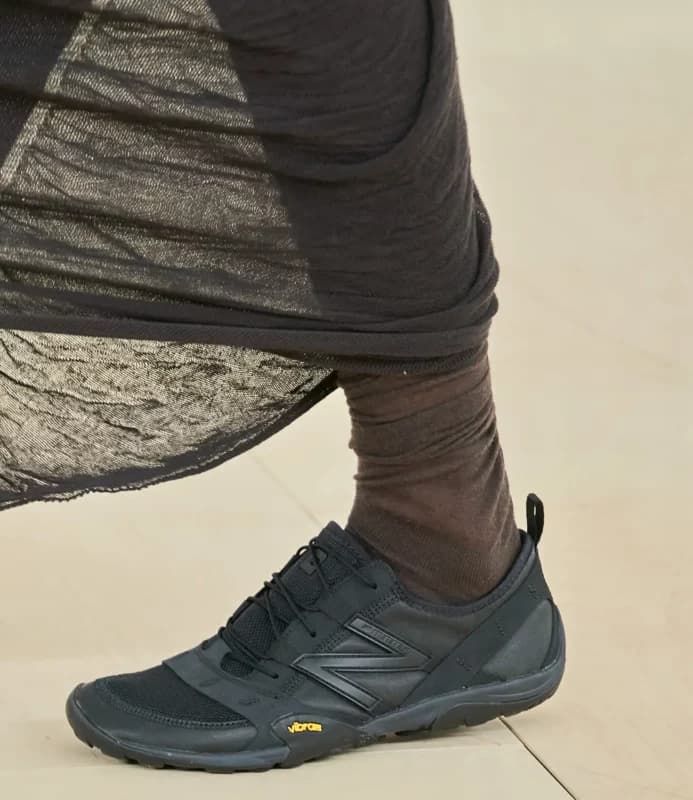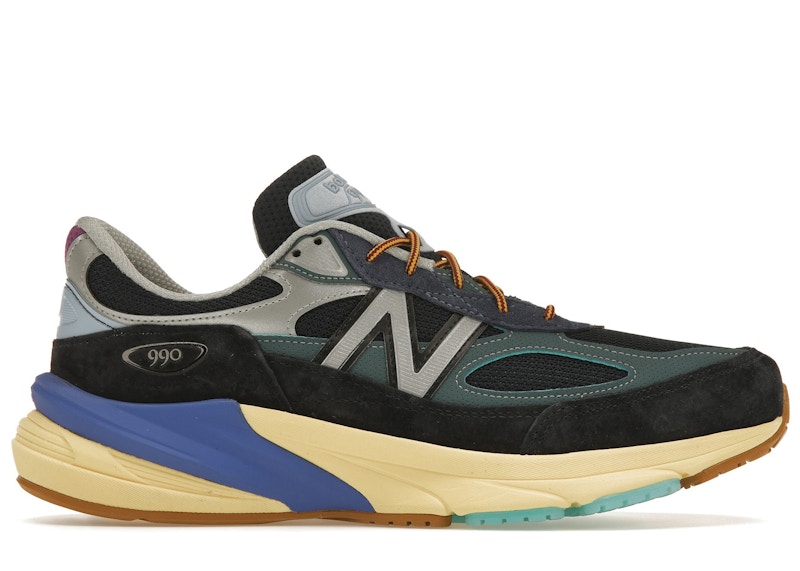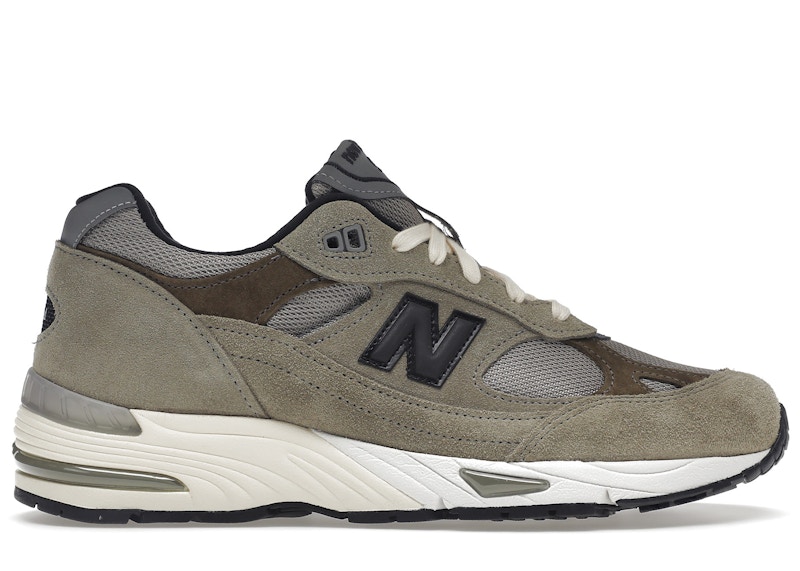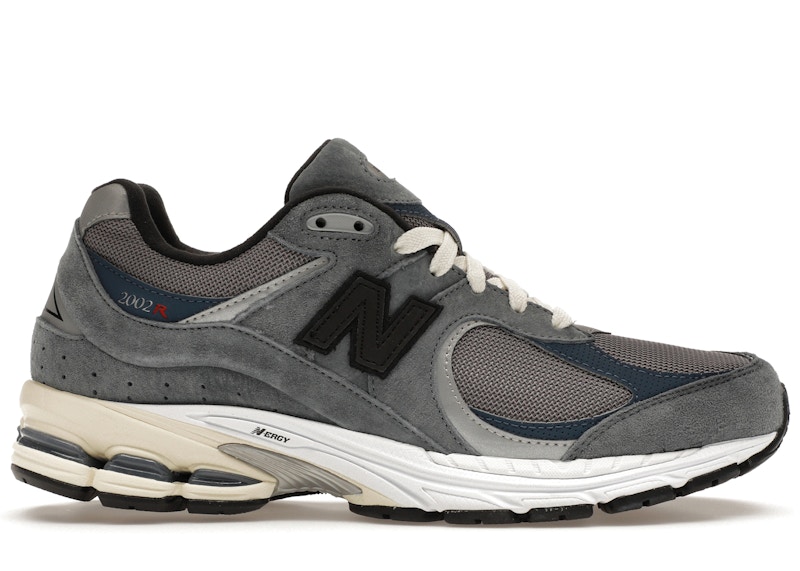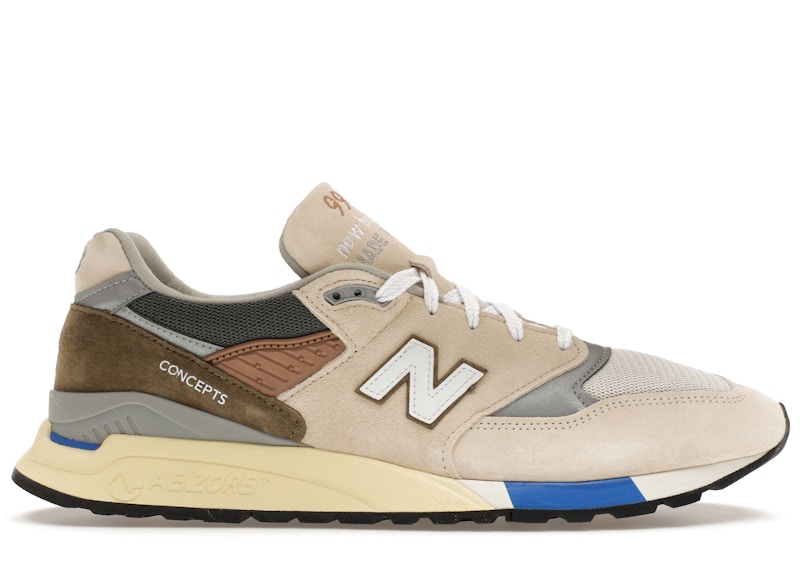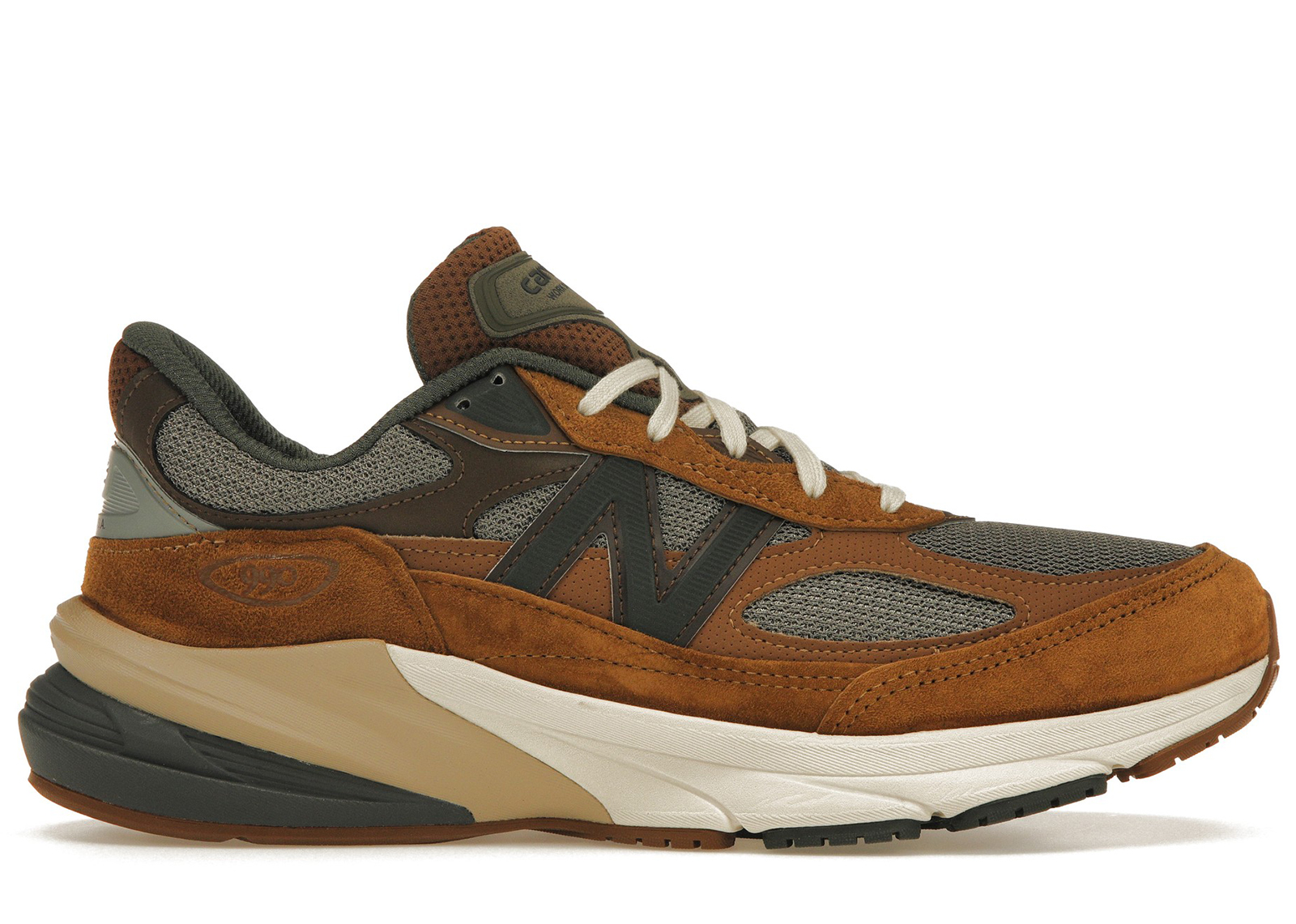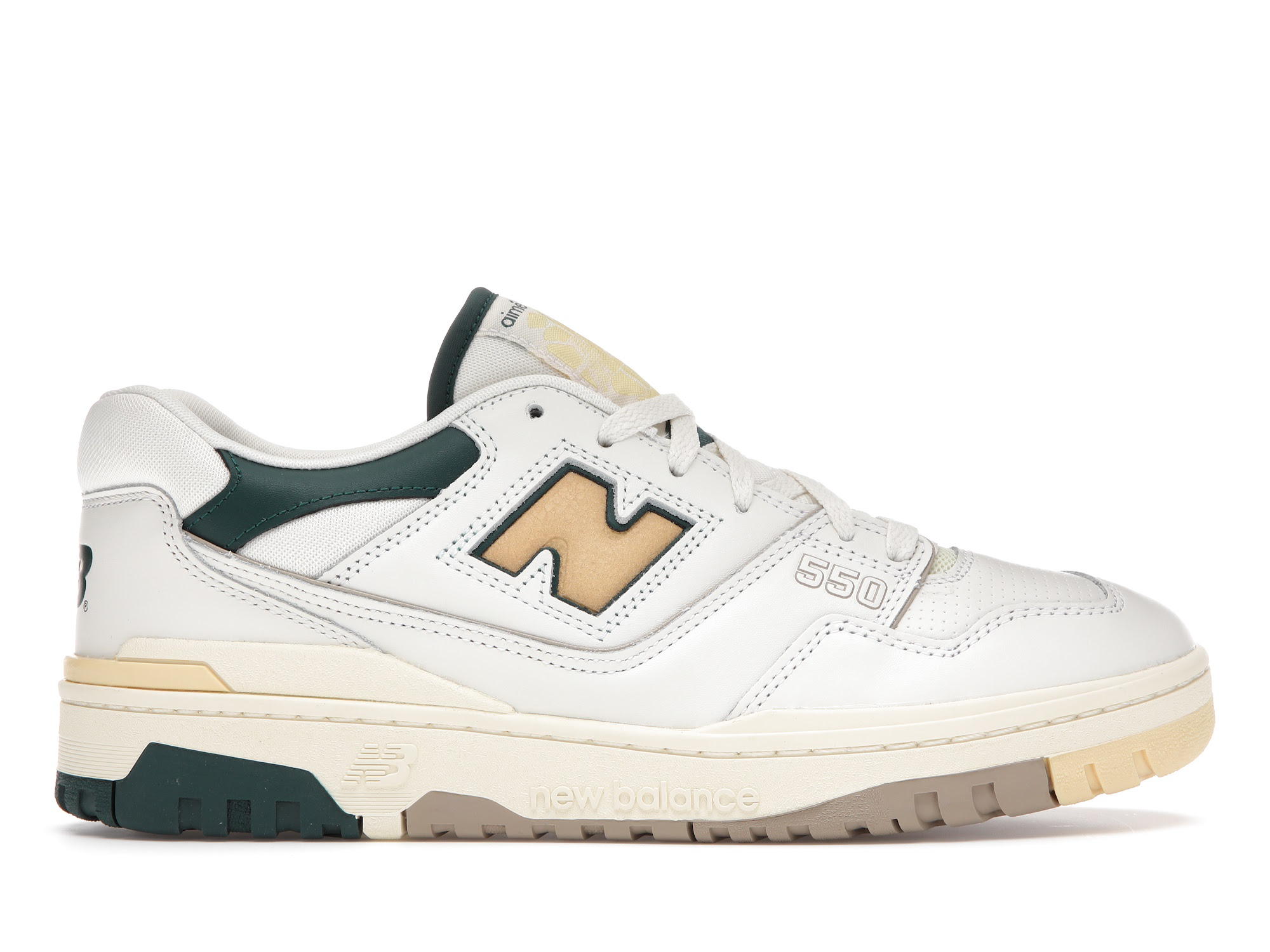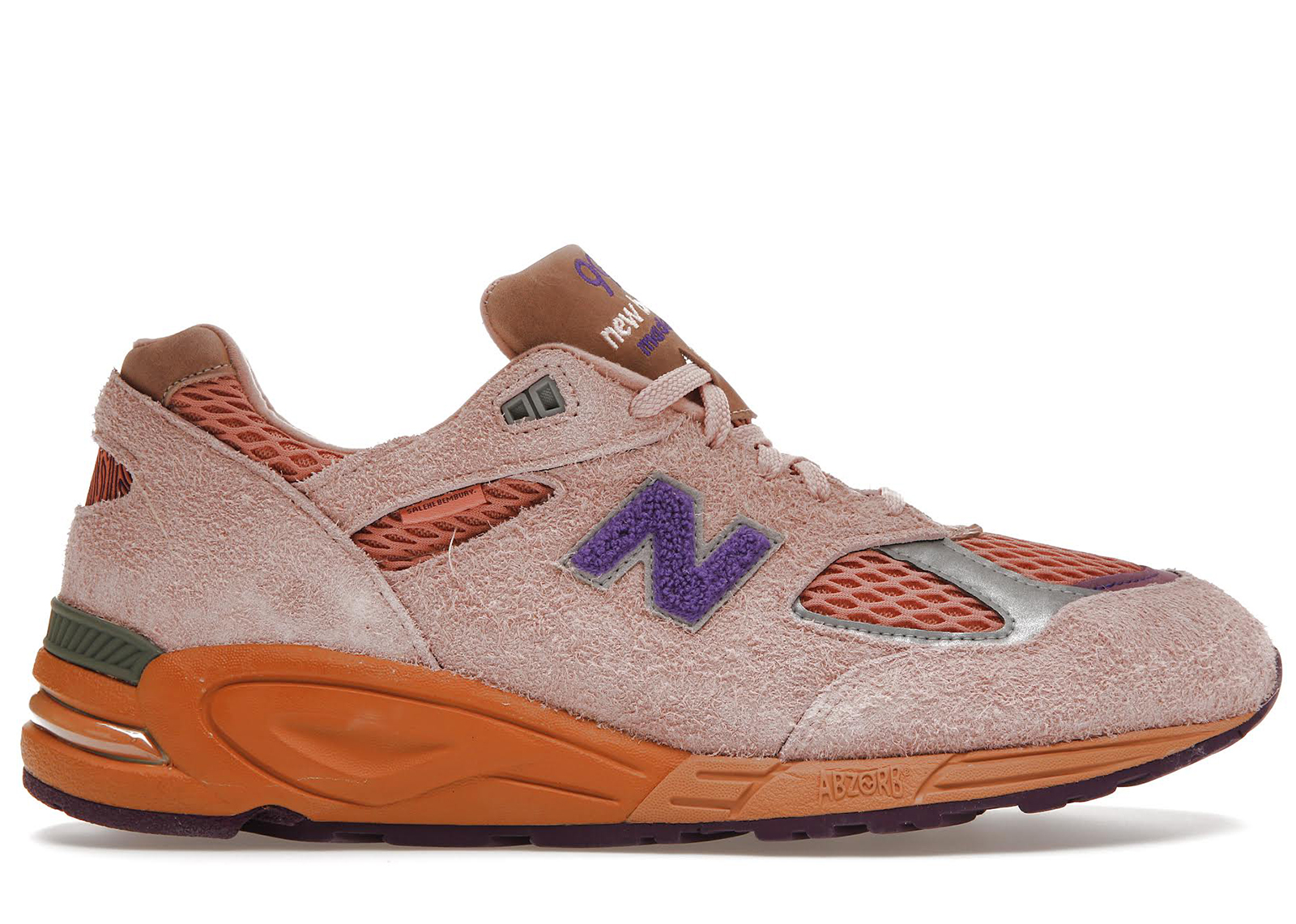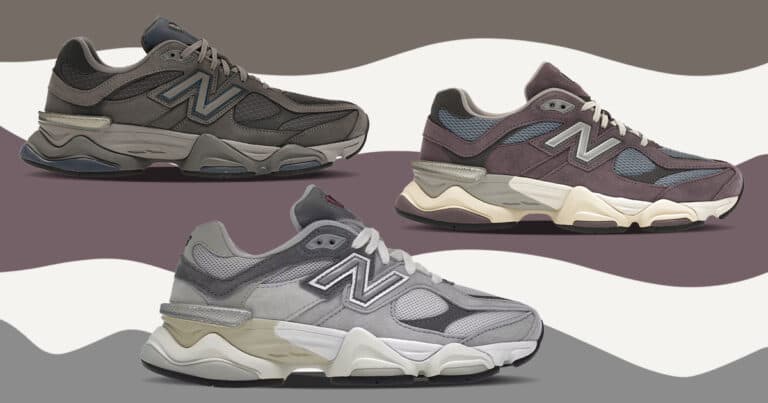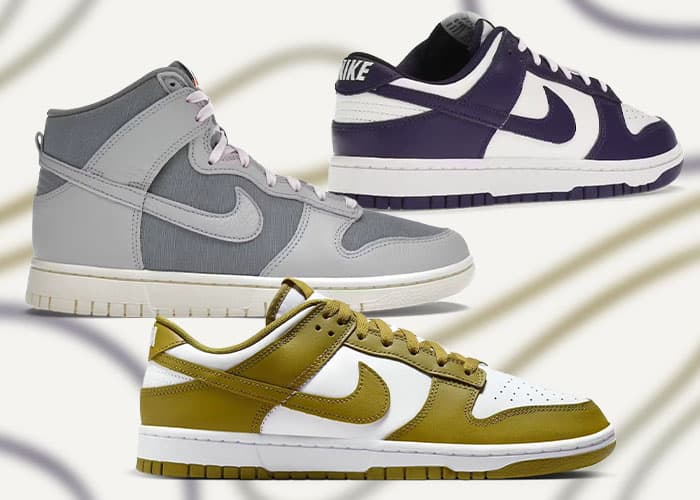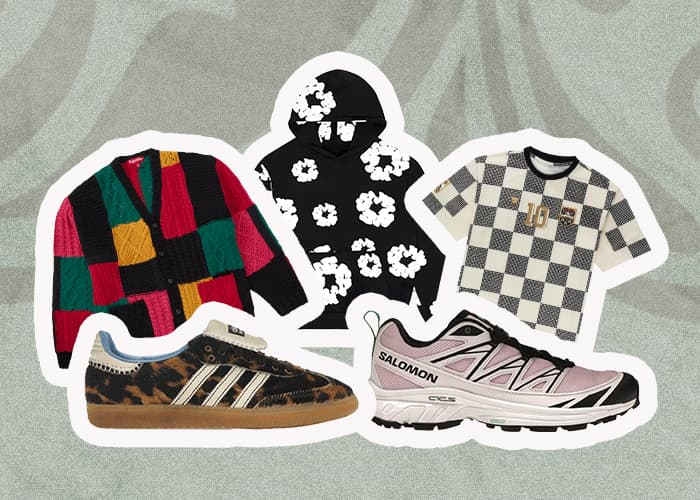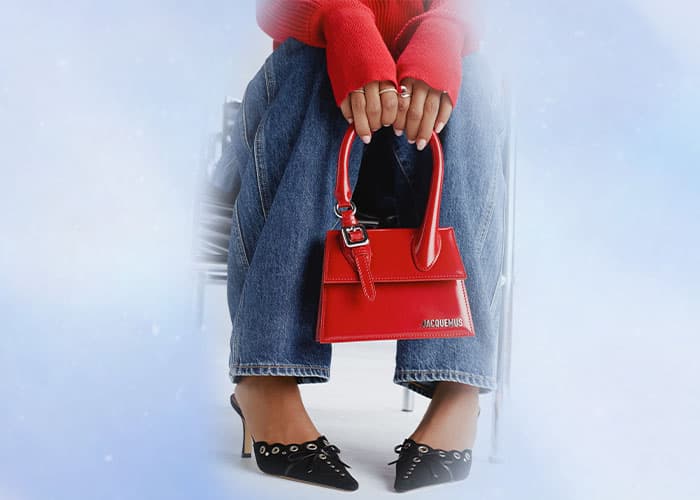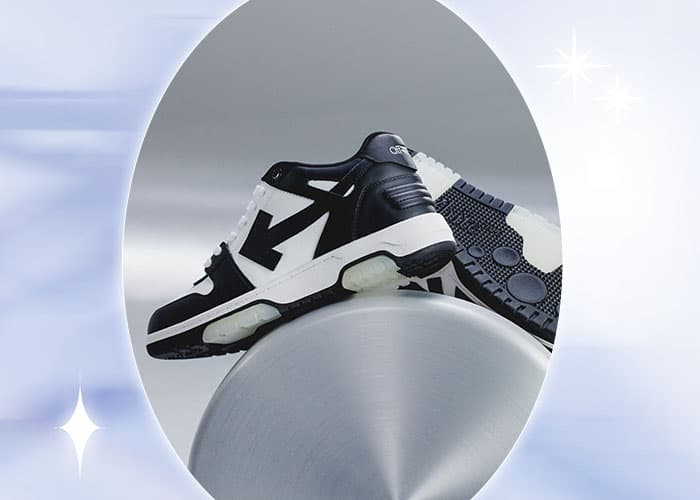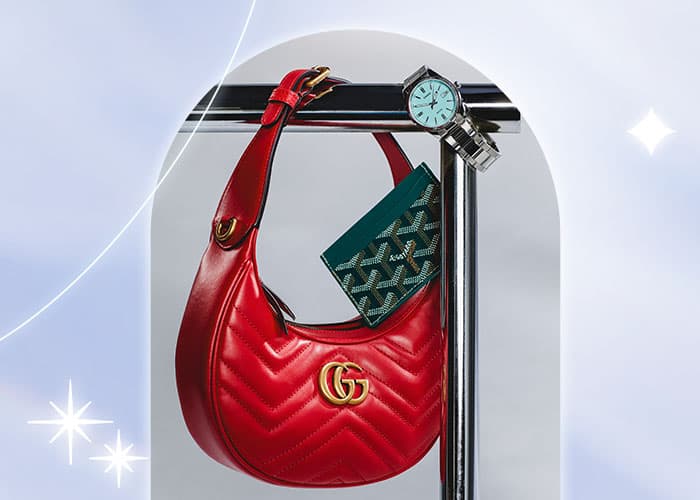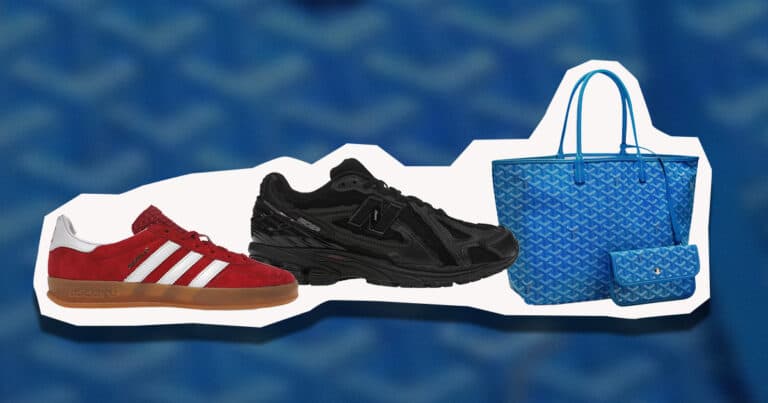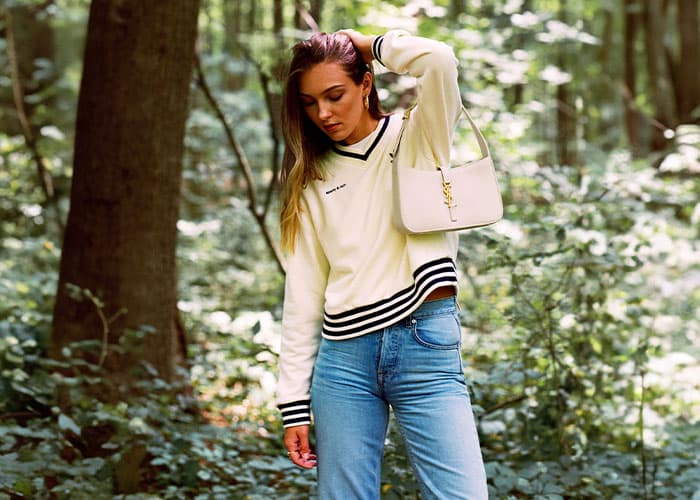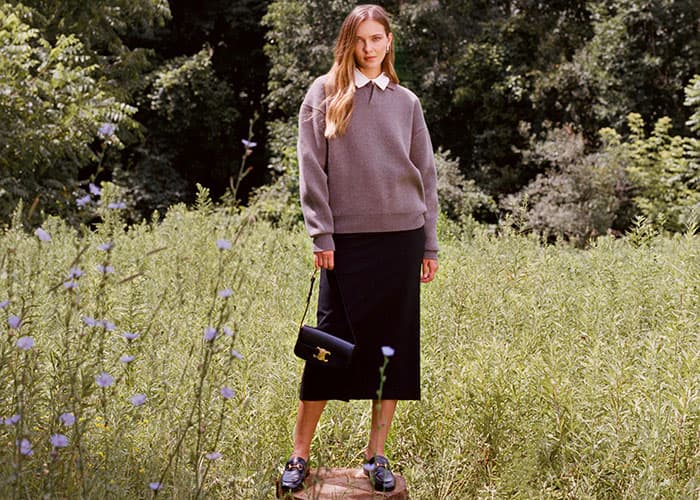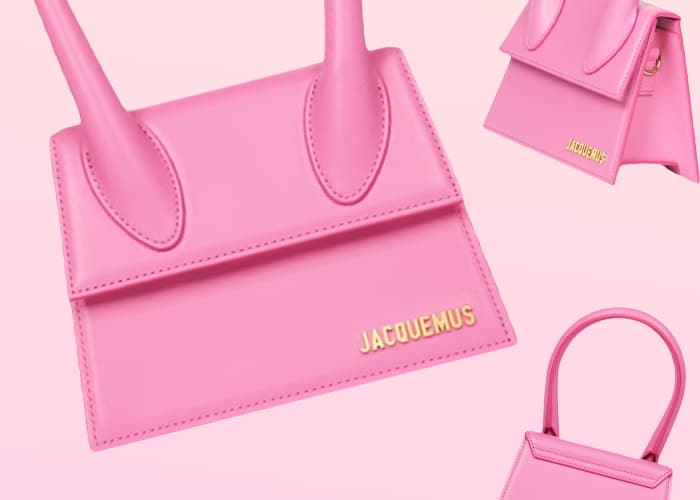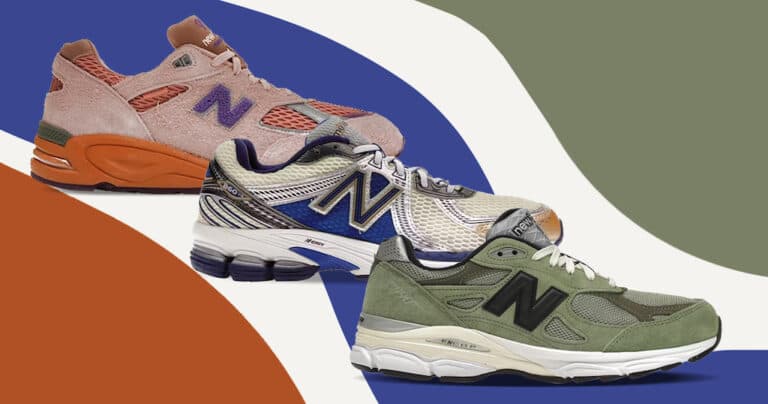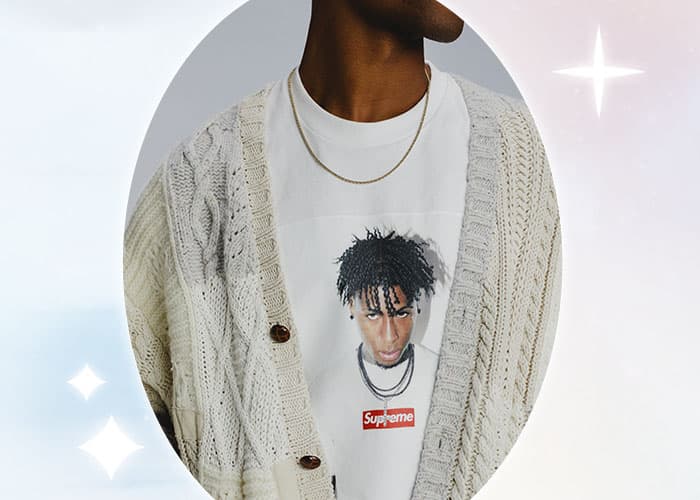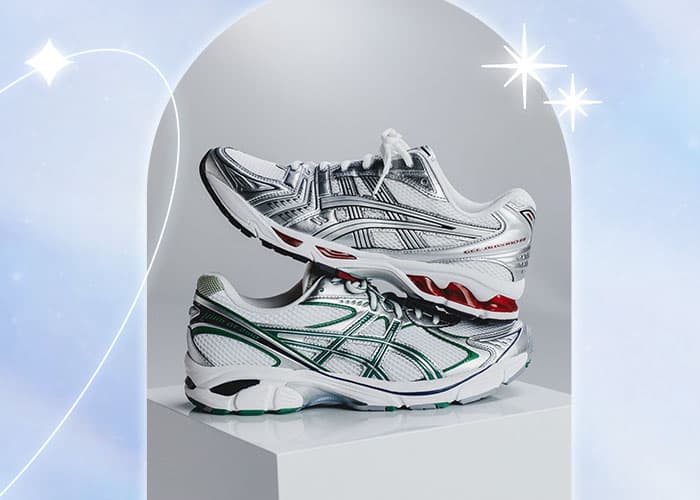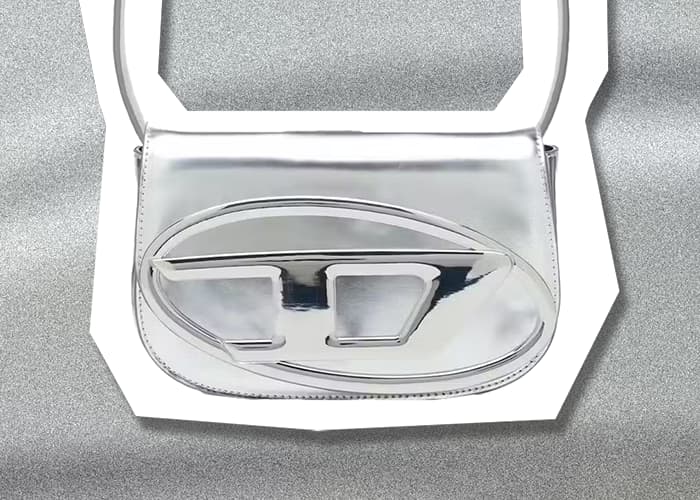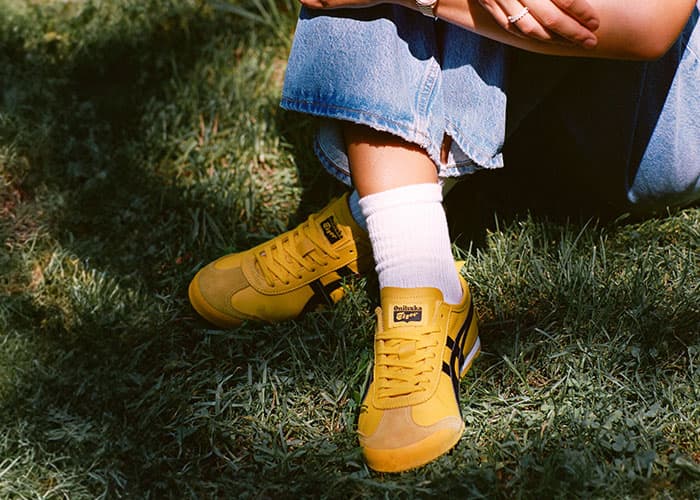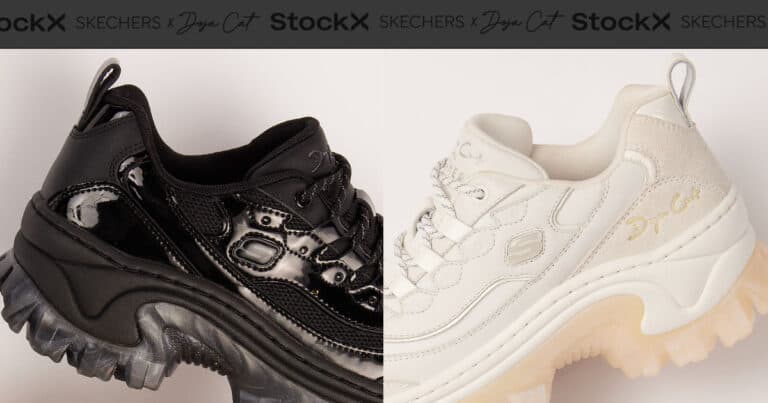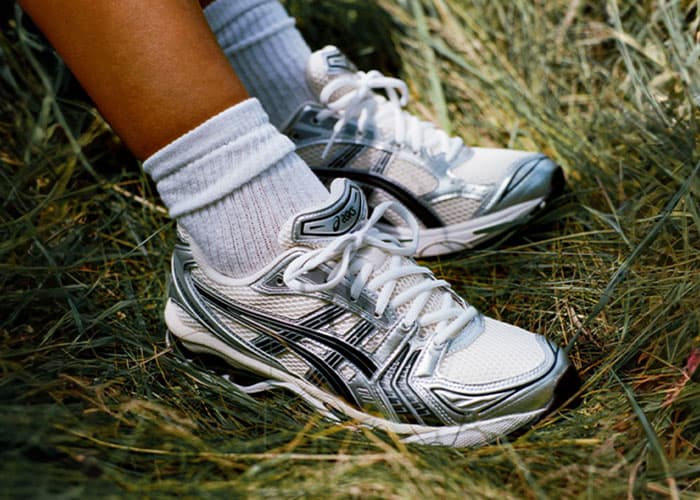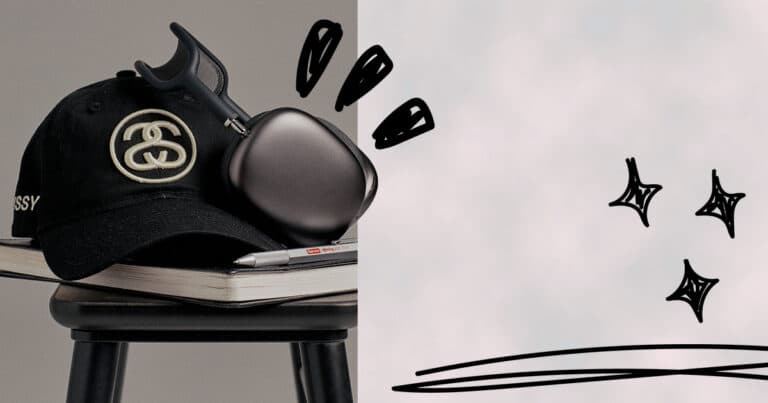It’s true: New Balance was not always this cool. Just ask any Millennial and they’ll remember the days when you may or may not have been picked on for wearing those clunky dad sneakers to gym class. But now thanks to smart New Balance collabs, the brand has reinvented itself as the type of cool that has that undeniable “if you know, you know” allure. So how did a company go from having a dorky dad sneaker reputation to becoming the ultimate fashion-forward streetwear brand?
The answer is simple: collaborations. New Balance’s finger on the pulse and care for their products above all else allowed them to bring in a wave of innovative collaborators that resonated with youth culture. By teaming up with Gen Z and Millennial favorites like Aimé Leon Dore, Kith, and Joe Freshgoods, New Balance quickly got back on the map as not just a runner staple, but a streetwear icon. They did the unthinkable: transforming the term “dad sneaker” into a compliment. As the chunky silhouette took off with younger audiences who had a newfound obsession with Y2K nostalgia, New Balance capitalized on the trend by reintroducing older styles with a contemporary spin, created through the eyes of relevant brands, artists, and designers that were relevant with current culture.
New Balance’s smart collaborations captured the attention of streetwear and sneaker lovers, but also the fashion industry, with the brand having a 200% trade growth on StockX from 2021 to 2022. So whether you’ve always had a thing for New Balance or caught on to the recent collab wave, it’s important to dive into the brand’s rich history first before setting your eyes on that next pair.
Here is everything you need to know about New Balance collabs before buying.
Image via Alchetron
A Brief History of New Balance
Before we get into where the brand is now, it’s important to learn where it all started. New Balance was founded by Irish immigrant William J. Riley in 1906 in Boston, Massachusetts. Riley’s goal was to provide a new level of comfort and arch support to workers, initially naming the brand the New Balance Arch Support System. After watching his chickens walk with perfect balance on their three-toed feet, Riley came up with the idea to mimic this theory in a shoe, leading to the three support points found in his arch support products.
For the first few decades, New Balance catered to workers who spent long hours on their feet and needed that extra arch support. It wasn’t until 1961 when New Balance started to attract athletes also looking for a cushioned sole. New Balance thus introduced the Trackster, its first running shoe available in different width sizes, which gained widespread popularity in the running community. The Trackster had an innovative design featuring a ripple sole for traction, which allowed for a more comfortable and high-performance fit for athletes.
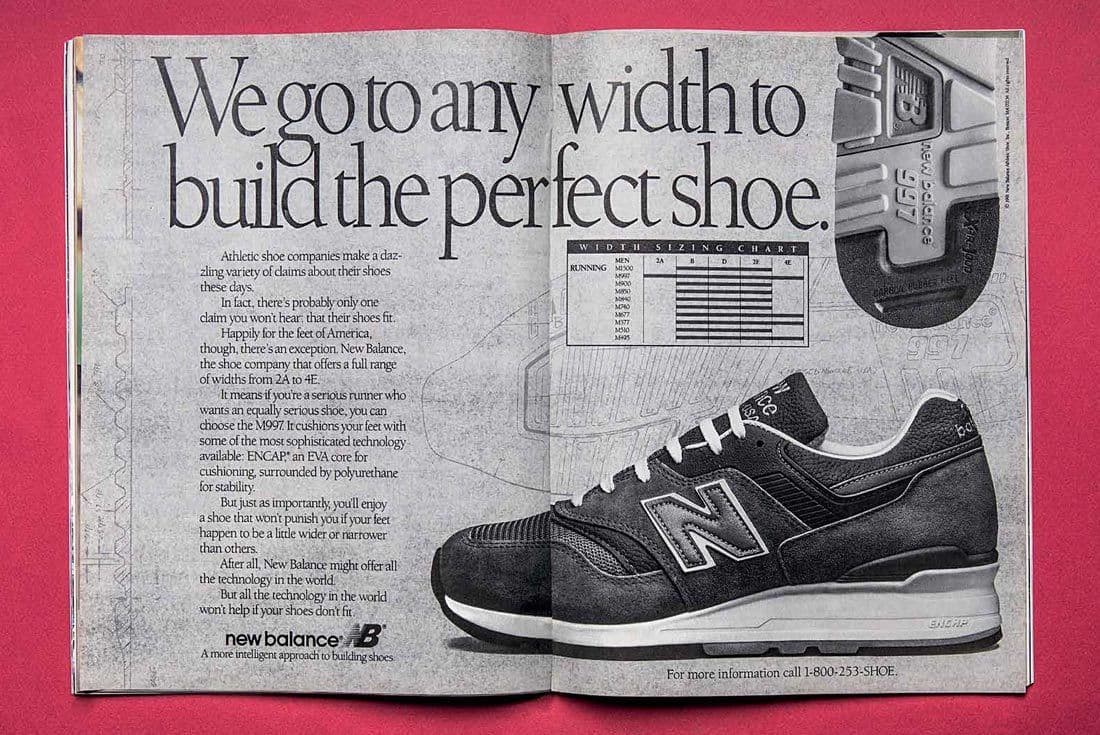
Image via ImlaShops
The Trackster was a huge success, but New Balance still had more of a niche following compared to the mainstream success it has today in the sneaker market. It wasn’t until the 1972 Boston Marathon when New Balance really took off running. The current chairman, Jim Davis, purchased the company and guided the brand to become one of the leaders in the sneaker world.
New Balance owes a lot of their early success to great products but even better timing. Running started to grow as a hobby in the late 80s, giving New Balance an opportunity to release models that appealed to this newfound generation of runners. The brand started to release unique model numbers with a variety of widths that catered to each individual consumer. The model numbers defined the type of shoe, the activity it was designed for, and whether the sneaker was built for stability, speed, or support. In 1976, New Balance released the first sneaker with the now-iconic “N” logo: the 320. Crafted from nylon and suede, the New Balance 320 quickly became the number one running shoe on the market, giving the brand its global breakthrough.
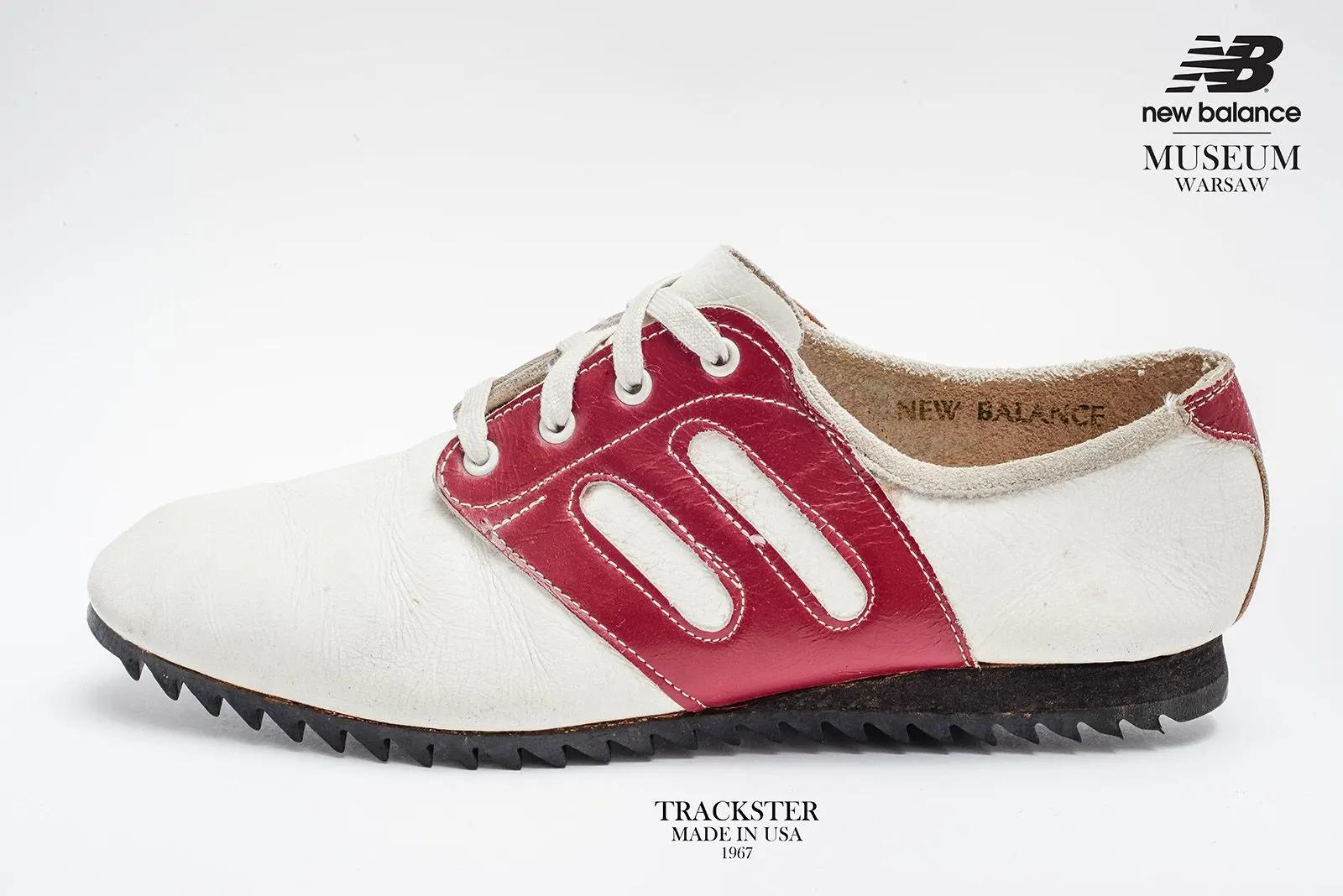
Image via asphaltgold
Since then, New Balance has released a wide variety of successful products, from the famous 574 that took New Balance outside the running world and into the streets, to the 990, 550, and recently the popular 9060.
While New Balance had established itself as a respected brand within the realm of performance footwear, the landscape of the sneaker industry underwent a seismic shift in the late 20th century with the rise of sneaker culture. As consumers sought out sneakers not only for their functionality but also for their style and cultural significance, New Balance recognized the importance of engaging with this growing market and passion.
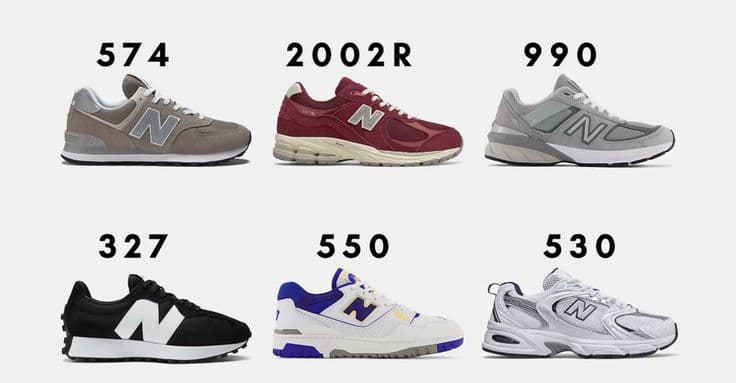
Image via OnPointFresh
Enter collaborations: a strategic move that would not only introduce New Balance to a new audience but also breathe fresh life into the brand. By partnering with influential figures from the worlds of fashion, art, and streetwear, New Balance began to infuse its classic silhouettes with fresh perspectives, creative storytelling, and innovative design elements, attracting a diverse array of sneaker enthusiasts and fashion-forward consumers.
The ALD Effect
Trends function as a cycle, so it was no surprise when “dad shoes” started to circulate across social media again. Gen Z became obsessed with everything Y2K, and this affinity for the past helped the dad shoe become not only cool, but a cultural phenomenon. Knowing they were the dad shoe brand, New Balance saw this as an opportunity to connect to a younger audience. To create conversation around their beloved dad sneakers, New Balance decided to partner with relevant creators that could reintroduce the brand’s heritage with a modern take to the current audience of runners, streetwear enthusiasts, and fashion lovers.
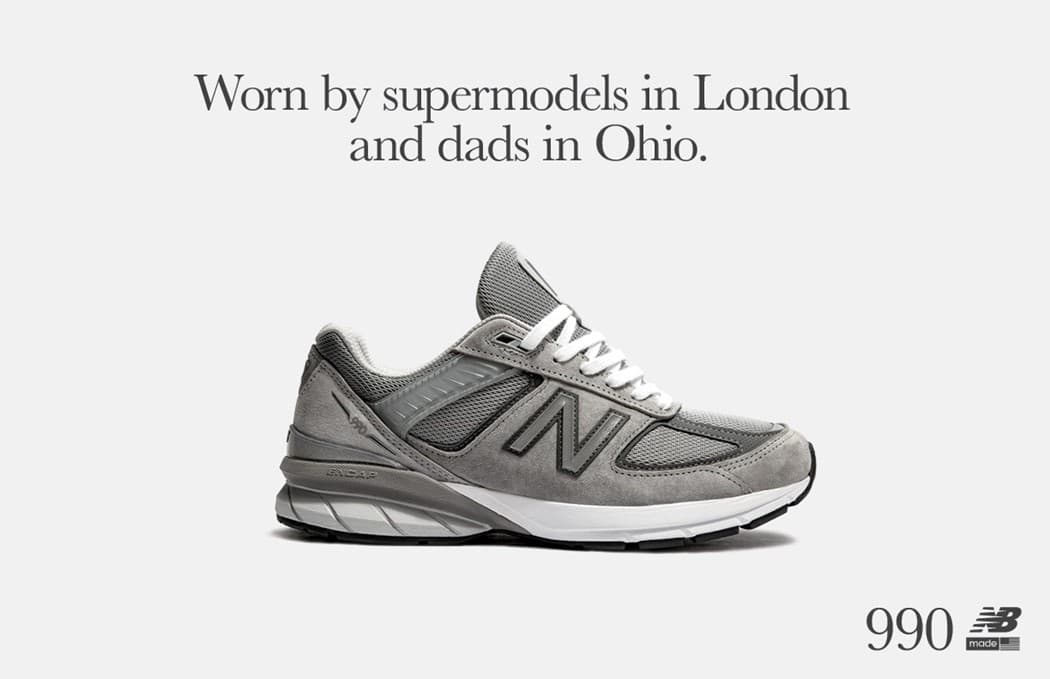
While New Balance had been working with outside partners for years at this point, it wasn’t until New York-based label Aimé Leon Dore and its founder Teddy Santis teamed up with the Boston brand when things really took off. Founded in 2014 by Santis, Aimé Leon Dore is a brand deeply rooted in Santis’s New York upbringing. His love for the city’s street culture – from basketball to art, and fashion – is seen in his vintage-inspired, timeless designs.
Santis’s passion for 90s nostalgia helped him create New Balance collabs that felt genuine, which really resonated with the younger audience. They began their collaboration in 2019 by crafting iterations of the 997 model. While the 997 collab received a lot of attention and approval from the media, it wasn’t until the 550 release when New Balance really started to own the collab conversation in sneakers and streetwear.
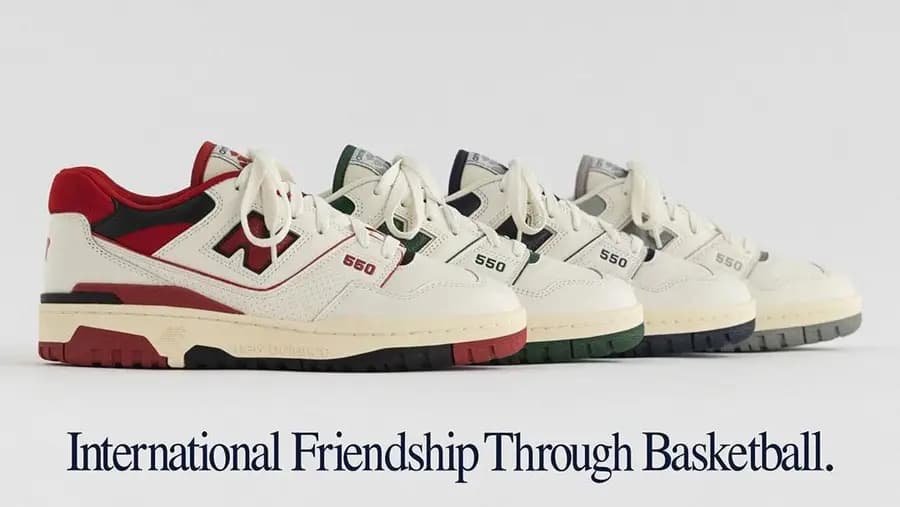
Santis discovered the 550 model by flipping through an old Japanese magazine, instantly falling in love with the vintage-inspired aesthetic and reminding him of his love for 90s New York City basketball culture. He decided he wanted to use the 550 model for his next New Balance collab, but bring the dated silhouette into the new age with updated colorways. Santis designed the 2020 models with a series of collegiate colors and vintage finishes, creatively fusing New Balance’s history with the current age of fashion. The New Balance x Aimé Leon Dore 550 collaboration not only cemented the relationship between the two partners, but was also met with critical acclaim and a major demand for the releases online. So much so, the collab started selling on the resale market for more than double its price.
Aimé Leon Dore x New Balance 860v2 White
Aimé Leon Dore x New Balance 860v2 Blue
Aimé Leon Dore x New Balance 550 White Green
Aimé Leon Dore x New Balance 993 Taupe (Women’s)
Aimé Leon Dore x New Balance 1300 Green
Both Aimé Leon Dore and New Balance benefited greatly from the collaboration. Teddy Santis became the Creative Director of the New Balance Made in USA line, bringing his distinctive storytelling and keen eye for design to the role. While the collaboration cemented New Balance as a key contender in the fashion market, transforming them from dated dad shoe to a leader in high quality streetwear.
What are some of the top Aimé Leon Dore and New Balance collabs?
While the Aimé Leon Dore-crafted 550 established New Balance as a leading contender in the collaboration space, there are a lot of releases the two brands teamed up on that are just as noteworthy and highly sought after. See a few below:
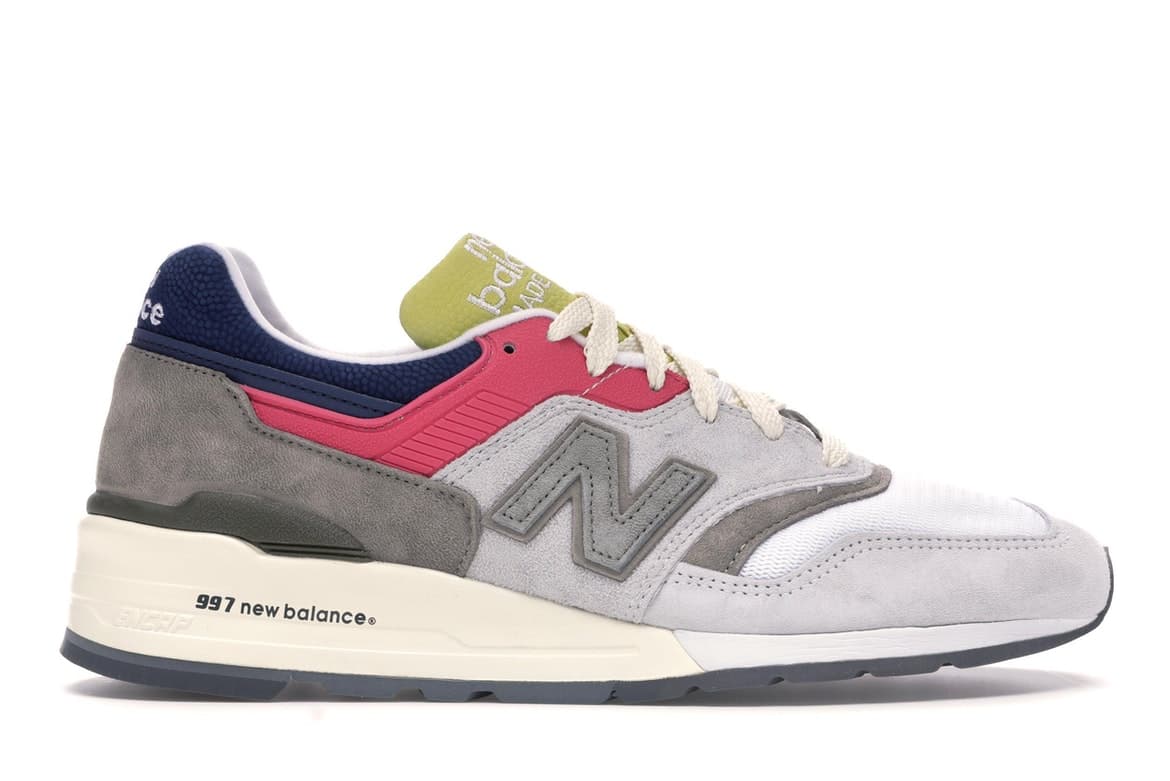
Aimé Leon Dore x New Balance 997
This was the collaboration that kicked off the now iconic partnership. The Aimé Leon Dore x New Balance 997 came with two colorways in neutral shades contrasted by pops of vibrant colors on the tongue, collar, and eyestays. The New Balance collab showed off Teddy Santis’s knack for updating classic runner models and giving them a modern makeover. Many devoted fans still consider this one of the best collabs to come out of the partnership, with some pairs selling for around $1,000 USD today.
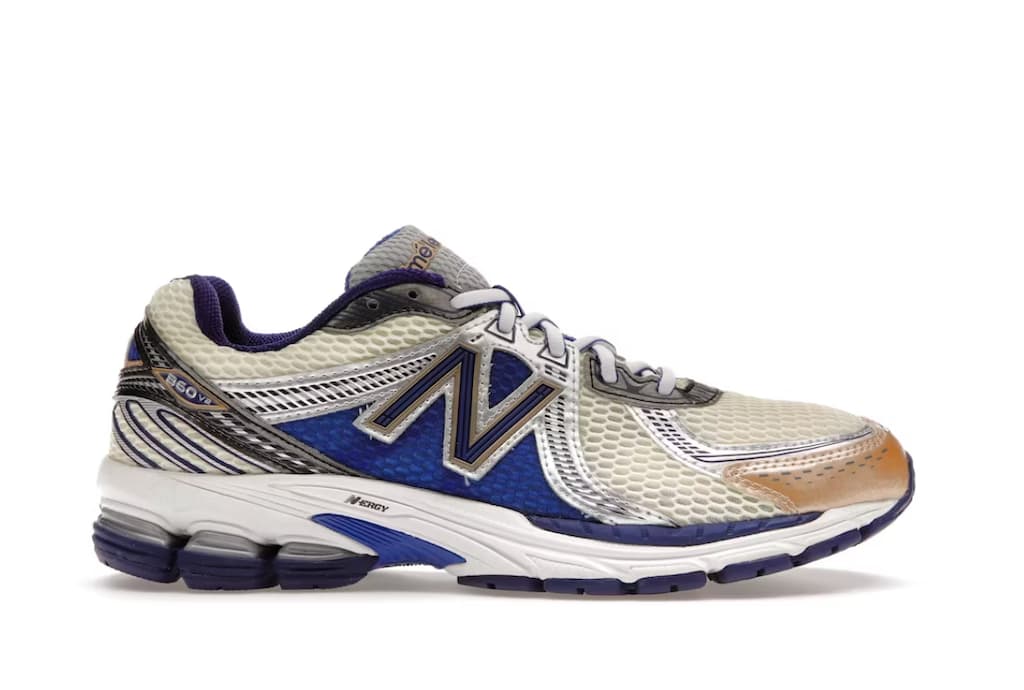
Aimé Leon Dore x New Balance 860v2 Blue
This popular release proves that two brands can showcase their unique elements while still telling a cohesive story together. The shoe nods to each company’s ethos in the design, with the classic silhouette paying homage to New Balance’s running history and the intentional vintage elements highlighting ALD’s design details. It’s a model that went under the radar when first released and Aimé Leon Dore breathed fresh new life into it, reintroducing the style to a younger generation of New Balance lovers who missed out the first time around.
Aimé Leon Dore x New Balance 1906R Jade
A personal favorite, the Aimé Leon Dore x New Balance 1906R collab showed off the power of the ALD effect. Given that it’s a vintage running shoe, it makes sense why Teddy Santis wanted to put his contemporary touch on the classic style. The sneaker was released in a modern Jade and White colorway, featuring a green suede upper with white leather accents and a gum sole. Another hit from the power couple of collaborations.
Aimé Leon Dore x New Balance 550 Natural Green
Last but certainly not least, the iconic 550 in Natural Green. Devoted New Balance followers will say this may be the colorway that started the full ALD effect. The combination of the vintage-looking natural green with the off-white and yellow tones make this sneaker feel like it was pulled right from the 90s archives.
What are some of the most popular New Balance collabs of all time?
The partnership with Aimé Leon Dore may have set the fuse, but the fire has been burning ever since for New Balance as they continue to team up with strategically chosen artists, designers, and creators in current culture. New Balance has made it very clear that collaboration is a key part to the brand’s ethos, and it’s clearly been working. From Kith to Joe Freshgoods, Stüssy, and GANNI, New Balance has chosen relevant collaborators that have unique stories to tell. Here are some of the most popular New Balance collabs of all time:

New Balance x Concepts 998 “C-Note” 10th Anniversary
Originally released in 2013, the 10th Anniversary iteration celebrates the OG sneaker with a similar Sea Salt and Covert Green colorway. The OG sneaker was inspired by the new design of the one hundred dollar bill, and the 2023 model continues to honor the value of paper currency. What makes this collab so popular is that it feels like a hidden gem from the past, like a thrifted find from the New Balance archives with its intentional vintage design.

New Balance x Salehe Bembury 2002R “Peace in the Journey”
Salehe Bembury always knows how to push the creative boundaries when it comes to sneaker storytelling. The Burnt Orange, Yellow, and Blue colorway draws inspiration from Antelope Canyon, the place Bembury would take his early morning hikes. From the textures to the color palette and packaging, every specific detail plays into the desert imagery, showcasing Bembury’s talent for transforming sneakers into a work of art.

New Balance x Joe Freshgoods 990v3 “Outside Clothes”
Joe Freshgoods started off strong when it came to his New Balance collabs. People questioned if he could ever beat his hugely successful first release “No Emotions Are Emotions.” But then the 990v3 “Outside Clothes” was released, and the doubt dissipated. Joe Freshgoods proves that he is no one hit wonder in the New Balance collab game. The colorway stands out against the rest of the 990v3 models, as it has a questionable combination at first glance. The more you train your eyes to the Desert Rose and Blue tones, the more you realize the purposeful play of hues that represent nature – from the dirt brown melting into the sky blues and grassy greens. It’s collaboration genius at its finest.
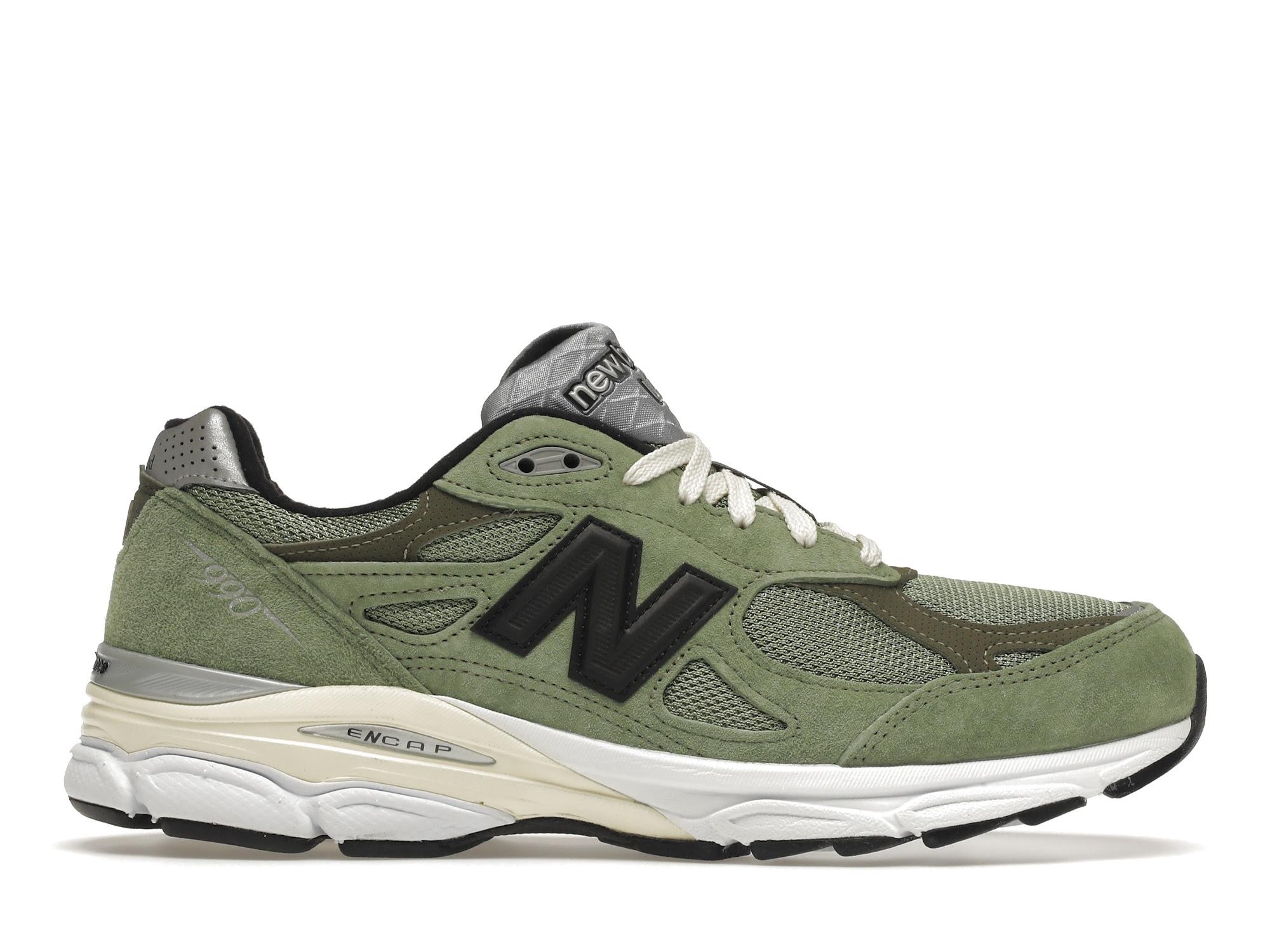 New Balance 990v3 MiUSA JJJJound Olive
New Balance 990v3 MiUSA JJJJound Olive
A celebrity favorite, the JJJJound 990v3 Olive release proved that sometimes the best collaborations don’t have to turn heads with a bright and bold colorway. The minimalist approach to the classic New Balance silhouette is what actually makes this collaboration stand out from the rest. It fuses JJJJound’s stripped-back yet elevated aesthetic with the heritage running silhouette, making this style feel fashion-forward, on-trend, and forever timeless.
Other notable collabs include New Balance x Levi’s 580, New Balance x Stüssy 990 Cream, New Balance x GANNI 2002R, New Balance x Action Bronson 990v6 Baklava, and the New Balance 990v6 MiUSA Ronnie Fieg Madison Square Garden Sandrift.
How do New Balance shoes fit?
It’s important to know your size before ordering your next New Balance collab shoe. New Balance shoes run true to size, so we recommend getting your usual size when buying. When it comes to width, New Balance is proud to offer multiple options, as feet come in all different shapes and sizes. The narrowest is a 2A and the widest is a 6E, while the standard width size is D. See below for their width guide:

What do New Balance’s Numbers Mean?
The brand didn’t want to fall into the marketing trap of naming their shoes after gimmicky naming conventions. Instead, New Balance kept it simple, informative, and performance-driven. They developed a functional numeral system to differentiate each models and its specific features. Their 6-7 digit coding system may seem complicated, but it’s actually pretty straightforward. To decipher the code, you’ll need to look at three parts: the letters before the number, the last two digits of the number, and the letters after the number.
When it comes to the letters before the number (part 1 of the deciphering trick), each one or two letter code before the New Balance shoe’s model number signifies the type of person and activity it is meant for. According to the brand, the codes are as follows:
- MT = Men’s Trail
- WT = Women’s Trail
- MW = Men’s Walking
- WW = Women’s Walking
- MX = Men’s Cross-Training
- WX = Women’s Cross-Training
- MC/MCH/MCY = Men’s Tennis
- WC/WCH/WCY = Women’s Tennis
- US = Made in the USA
- G = grade school
- P = preschool
- I = infant
- Y = youth (preschool and grade school)
Sometimes they will drop the M or W altogether, or you will find special codes like “BB” for classic basketball shoes.
It’s important to note that a higher total number generally means a more technologically complex shoe. However, it’s really the last two digits of the number you need to look at when it comes to finding your next pair. The last two digitals of the number tell you the general purpose of the shoe, which helps you know more about the size and fit based on what it was built for. See below for the guide:
- 40 shoes are for control, with comfortable cushioning and stability. They are best for people with knee or foot injuries since they provide next-level support.
- 50 shoes are for running and fitness. They are adaptable to both indoor and outdoor workouts and provide great agility for quick movements.
- 60 shoes are your stability sneakers. They’re designed to reduce pronation and offer maximum cushion and support.
- 70 shoes have lighter stability. They fall between the design of 50s and 60s, making them ideal for athletes who want a lightweight sneaker that still provides ample support.
- 80 shoes are neutral and are ideal for hobby runners who love a lightweight design and construction.
- 90 shoes are for speed. They are crafted with competitive runners in mind and offer a snug fit and springy resistance.
Lastly, the letters after the number simply indicate the main colors or materials the shoes come in. WB signifies white and blue, BK is for black, and GTX implies the shoe is made with Gore-Tex uppers. And what about that lower case ‘v’ you see in some codes? The ‘v’ means that the sneaker has gone through different versions, each with a change or improvement from the last iteration. So if you see “v5” you know the sneaker has 5 different renditions and you can go back in the archive to see which one you connect with most.
What New Balance collabs are releasing in 2024?
When two of the buzziest brands in fashion and streetwear collide, you know it’ll be sold out in seconds. That’s exactly what happened with the Miu Miu x New Balance 530 release this February. Other notable collab releases include the Aimé Leon Dore x New Balance 990v6 in Incense (released February 2024), and the hype-inducing Issey Miyake x New Balance MT10 rumored to be dropping Spring 2024.
Miu Miu x New Balance 530
Issey Miyake x New Balance MT10




